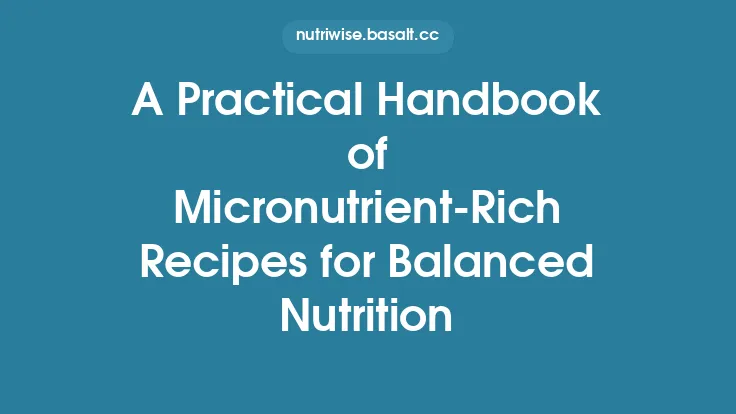Low‑sugar, high‑fiber cooking is a powerful way to support cardiovascular health without sacrificing flavor or satisfaction. By focusing on ingredients that naturally contain minimal simple sugars while delivering generous amounts of dietary fiber, home cooks can create meals that help regulate blood glucose, improve lipid profiles, and promote a feeling of fullness that discourages overeating. This article explores the science behind these nutrients, offers practical strategies for combining them, and provides a collection of detailed recipes that demonstrate how delicious heart‑friendly meals can be when sugar is kept low and fiber is kept high.
Why Low Sugar Matters for Heart Health
Excessive intake of added sugars has been linked to several risk factors for heart disease, including:
- Elevated triglycerides – High blood sugar spikes stimulate the liver to produce more triglycerides, a type of fat that can accumulate in arterial walls.
- Increased inflammation – Chronic consumption of refined sugars can trigger inflammatory pathways, contributing to endothelial dysfunction.
- Insulin resistance – Persistent high glucose levels force the pancreas to release more insulin, eventually leading to reduced cellular sensitivity and higher circulating insulin, both of which are associated with hypertension and atherogenic lipid changes.
By limiting added sugars and focusing on naturally low‑glycemic foods, you reduce these stressors on the cardiovascular system. The goal isn’t to eliminate sweetness entirely, but to replace refined sugars with alternatives that have a minimal impact on blood glucose.
The Role of Dietary Fiber in Cardiovascular Wellness
Fiber is a heterogeneous group of plant‑derived carbohydrates that resist digestion in the small intestine. It can be broadly classified into two categories:
| Type | Primary Functions | Cardiovascular Benefits |
|---|---|---|
| Soluble fiber (e.g., pectin, β‑glucan, psyllium) | Forms a viscous gel in the gut, slowing nutrient absorption | Lowers LDL‑cholesterol by binding bile acids; moderates post‑prandial glucose spikes |
| Insoluble fiber (e.g., cellulose, hemicellulose) | Adds bulk to stool, promoting regular bowel movements | Reduces systemic inflammation by supporting a healthy gut microbiome; may aid in weight management |
When fiber is consumed alongside carbohydrate sources, it blunts the rise in blood glucose, which in turn lessens the insulin surge that can promote lipid synthesis. Moreover, the fermentation of soluble fiber by colonic bacteria produces short‑chain fatty acids (SCFAs) such as acetate, propionate, and butyrate, which have been shown to improve endothelial function and lower blood pressure.
Balancing Sweetness and Fiber: Practical Strategies
- Choose naturally low‑sugar fruits – Berries (especially raspberries and blackberries) provide high fiber with relatively low sugar content. Pair them with a small amount of a non‑caloric sweetener if additional sweetness is desired.
- Incorporate fiber‑rich bulks – Adding chia seeds, ground flaxseed, or oat bran to smoothies, sauces, or baked goods boosts fiber without contributing sugar.
- Swap refined starches for fiber‑dense alternatives – Use cauliflower rice, shredded zucchini, or roasted root vegetables in place of white rice or potatoes.
- Leverage the sweetness of certain vegetables – Carrots, beets, and sweet potatoes contain natural sugars but also deliver substantial fiber; using them in moderation can provide a gentle sweetness while keeping overall sugar load low.
- Utilize sugar‑replacing techniques – Puree ripe bananas or applesauce (with skins retained for extra fiber) to add moisture and mild sweetness to baked items, reducing the need for added sugar.
Core Ingredients for Low‑Sugar, High‑Fiber Cooking
| Ingredient | Fiber (g per 100 g) | Typical Sugar (g per 100 g) | Typical Uses |
|---|---|---|---|
| Blackberries | 5.3 | 4.9 | Fresh salads, desserts, smoothies |
| Chia seeds | 34.4 | 0.0 | Puddings, thickening agents, topping |
| Lentils (cooked) | 7.9 | 1.8 | Soups, stews, salads |
| Rolled oats (dry) | 10.0 | 0.5 | Breakfast bowls, baking |
| Avocado | 6.7 | 0.7 | Dressings, spreads, smoothies |
| Unsweetened cocoa powder | 33.0 | 0.0 | Desserts, sauces |
| Almond flour | 12.5 | 3.9 | Baking, coating |
| Psyllium husk | 78.0 | 0.0 | Thickening, fiber boost in breads |
| Edamame (cooked) | 5.2 | 2.2 | Snacks, salads, stir‑fries |
| Coconut flour | 32.0 | 2.0 | Baking, thickening |
These ingredients can be mixed and matched to create a wide variety of dishes that stay within a low‑sugar framework while delivering a robust fiber profile.
Recipe Collection
Below are five fully developed recipes that illustrate how to combine low‑sugar and high‑fiber principles across different meals. Nutritional estimates are provided per serving and are based on standard ingredient quantities.
1. Berry‑Almond Breakfast Parfait (Serves 2)
Ingredients
- 150 g plain Greek yogurt (unsweetened, 2 % fat)
- 80 g mixed berries (blackberries, raspberries, blueberries)
- 2 Tbsp almond flour
- 1 Tbsp chia seeds
- 1 Tbsp unsweetened shredded coconut
- ½ tsp vanilla extract
- Optional: a drizzle of monk fruit syrup (≈1 tsp)
Method
- In a small bowl, whisk yogurt with vanilla extract.
- In a separate bowl, toss berries with almond flour and shredded coconut; this creates a light coating that adds texture and fiber.
- In two serving glasses, layer half of the yogurt, then half of the berry mixture, followed by a sprinkle of chia seeds.
- Repeat the layers, finishing with a final dusting of chia seeds and, if desired, a light drizzle of monk fruit syrup.
Nutritional Snapshot (per serving)
- Calories: 210 kcal
- Protein: 12 g
- Total Carbohydrate: 18 g (Fiber: 7 g, Sugar: 6 g)
- Fat: 11 g (mostly monounsaturated)
2. Savory Lentil & Roasted Veggie Soup (Serves 4)
Ingredients
- 1 cup dry brown lentils, rinsed
- 4 cups low‑sodium vegetable broth (use as a base, not a focus on sodium reduction)
- 1 cup cauliflower florets
- 1 cup diced carrots
- ½ cup diced celery
- 2 Tbsp ground flaxseed
- 1 tsp smoked paprika
- 1 tsp dried thyme
- 2 Tbsp extra‑virgin olive oil (optional for sautéing)
- Freshly ground black pepper, to taste
Method
- In a large pot, heat olive oil over medium heat. Add carrots and celery; sauté for 4 minutes until slightly softened.
- Add cauliflower, lentils, broth, smoked paprika, and thyme. Bring to a boil, then reduce to a simmer.
- Cook uncovered for 25‑30 minutes, or until lentils are tender.
- Stir in ground flaxseed during the last 5 minutes of cooking; this thickens the soup and adds soluble fiber.
- Adjust seasoning with pepper and serve hot.
Nutritional Snapshot (per serving)
- Calories: 180 kcal
- Protein: 11 g
- Total Carbohydrate: 30 g (Fiber: 12 g, Sugar: 5 g)
- Fat: 3 g
3. Zucchini Noodle “Pasta” with Avocado‑Cilantro Sauce (Serves 2)
Ingredients
- 2 medium zucchinis, spiralized into noodles
- 1 ripe avocado
- ¼ cup fresh cilantro leaves (optional for flavor, not a focus on herbs)
- 1 Tbsp lime juice
- 1 clove garlic, minced
- 2 Tbsp water (adjust for consistency)
- 1 Tbsp psyllium husk (adds fiber and helps emulsify)
- Pinch of sea salt (use sparingly)
Method
- Place avocado, cilantro, lime juice, garlic, water, psyllium husk, and a pinch of salt in a food processor. Blend until smooth and creamy.
- Toss zucchini noodles with the sauce until evenly coated. If the sauce is too thick, add a splash more water.
- Serve immediately, optionally garnished with a few extra cilantro leaves.
Nutritional Snapshot (per serving)
- Calories: 250 kcal
- Protein: 6 g
- Total Carbohydrate: 18 g (Fiber: 10 g, Sugar: 4 g)
- Fat: 20 g (predominantly monounsaturated from avocado)
4. Chia‑Cocoa Pudding (Serves 2)
Ingredients
- 3 Tbsp chia seeds
- 1 cup unsweetened almond milk
- 1 Tbsp unsweetened cocoa powder
- 1 tsp vanilla extract
- 1 tsp erythritol or another non‑caloric sweetener
- Fresh raspberries for topping (optional)
Method
- In a mixing bowl, whisk together almond milk, cocoa powder, vanilla, and erythritol until fully dissolved.
- Stir in chia seeds, ensuring they are evenly distributed.
- Cover and refrigerate for at least 4 hours, preferably overnight, allowing the mixture to thicken.
- Before serving, give the pudding a quick stir and top with a few raspberries for added texture and fiber.
Nutritional Snapshot (per serving)
- Calories: 150 kcal
- Protein: 4 g
- Total Carbohydrate: 12 g (Fiber: 9 g, Sugar: 3 g)
- Fat: 9 g
5. Edamame & Quinoa Salad with Lemon‑Tahini Dressing (Serves 3)
Ingredients
- ½ cup quinoa, rinsed and cooked (cooled)
- 1 cup shelled edamame (cooked)
- ½ cup diced red bell pepper (optional for color)
- ¼ cup finely chopped green onions (optional)
- 2 Tbsp tahini
- 1 Tbsp lemon juice
- 1 tsp Dijon mustard (adds tang without sugar)
- 1 Tbsp water (to thin dressing)
- Freshly ground pepper, to taste
Method
- In a large bowl, combine cooked quinoa, edamame, bell pepper, and green onions.
- In a small bowl, whisk together tahini, lemon juice, mustard, water, and pepper until smooth.
- Pour dressing over the salad and toss gently to coat all ingredients.
- Serve chilled or at room temperature.
Nutritional Snapshot (per serving)
- Calories: 220 kcal
- Protein: 10 g
- Total Carbohydrate: 28 g (Fiber: 8 g, Sugar: 2 g)
- Fat: 9 g (mostly from tahini)
Tips for Maintaining Fiber Integrity During Cooking
- Gentle Heat for Soluble Fibers – Soluble fibers can become overly gelatinous if boiled for extended periods, which may affect texture. Simmer rather than boil, and add them toward the end of cooking (e.g., chia seeds in sauces, psyllium in soups).
- Avoid Over‑Processing – Excessive blending can break down insoluble fiber structures, reducing the bulking effect. For salads and grain dishes, keep ingredients in their whole or coarsely chopped form.
- Steam, Don’t Boil – Steaming vegetables preserves cell walls, maintaining insoluble fiber content better than boiling, which can leach some soluble fiber into the cooking water.
- Use Whole Seeds and Grains – When a recipe calls for ground nuts or flours, consider retaining a portion of the whole form (e.g., sprinkle whole almond slivers over a dish) to provide a mix of fiber textures.
Adapting Recipes for Personal Preferences
- Vegan conversion – Replace Greek yogurt in the parfait with a plant‑based, high‑protein yogurt (e.g., soy or pea‑protein based) while keeping the same fiber‑rich toppings.
- Gluten‑free – All recipes above are naturally gluten‑free; if you need to substitute quinoa in the salad, try millet or buckwheat (both high in fiber).
- Spice level – Adjust smoked paprika or add a pinch of cayenne to the lentil soup for heat without introducing sugar or sodium.
- Texture tweaks – For a creamier avocado sauce, increase the water or add a tablespoon of unsweetened almond milk; for a thicker pudding, add an extra half‑teaspoon of chia seeds.
Putting It All Together: A Sample Day of Low‑Sugar, High‑Fiber Meals
| Meal | Dish | Approx. Fiber |
|---|---|---|
| Breakfast | Berry‑Almond Breakfast Parfait | 7 g |
| Mid‑Morning Snack | Handful of raw almonds + 1 small apple (skin on) | 5 g |
| Lunch | Edamame & Quinoa Salad with Lemon‑Tahini Dressing | 8 g |
| Afternoon Snack | Chia‑Cocoa Pudding | 9 g |
| Dinner | Savory Lentil & Roasted Veggie Soup + Zucchini Noodle “Pasta” with Avocado‑Cilantro Sauce | 22 g (combined) |
| Total Daily Fiber | — | 51 g |
The recommended daily fiber intake for adults ranges from 25 g (women) to 38 g (men). This sample menu comfortably exceeds those guidelines while keeping added sugars well under 25 g, aligning with heart‑health recommendations.
By thoughtfully selecting low‑sugar, high‑fiber ingredients and employing cooking methods that preserve their nutritional qualities, you can craft meals that nourish the heart, stabilize blood glucose, and keep you feeling satisfied throughout the day. The recipes and strategies presented here are designed to be adaptable, allowing you to experiment with flavors, textures, and seasonal variations while staying firmly within the low‑sugar, high‑fiber framework that supports cardiovascular wellness. Enjoy the process of creating meals that are as kind to your heart as they are delightful to your palate.





